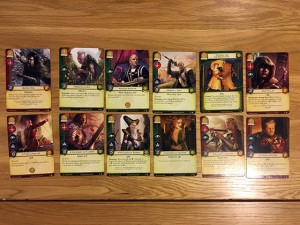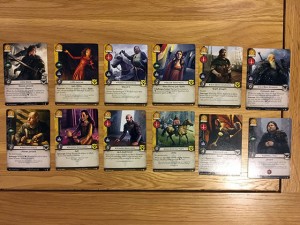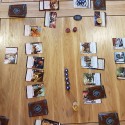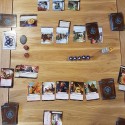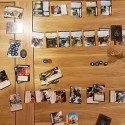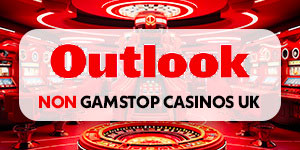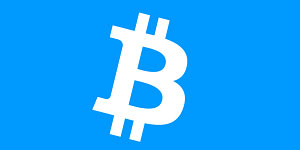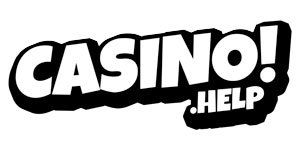‘Game of Thrones: The Card Game’ Review
If you’re anything like me, you’ll have been waiting for the latest season of HBO’s Game of Thrones adaptation with baited breath. No doubt, you’ll also have been hoping and praying that the treacherous winds of Westeros blow favourably for your favourite characters as the epic series draws to a conclusion. But what if you could influence the fate of each faction in Game of Thrones? What if Ned Stark had forsaken his friend Robert Baratheon and pledged his allegiance to House Lannister? What if Daenerys Targaryen had allied with House Martell?
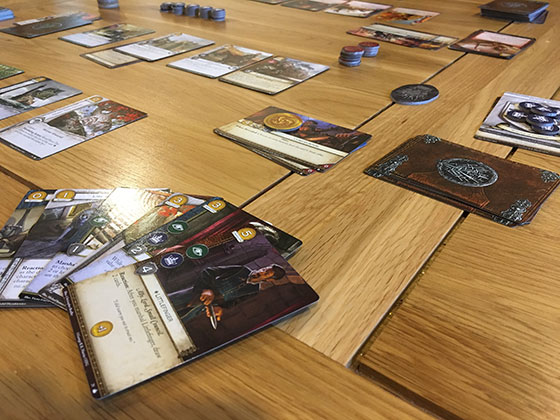
Introduction
Game of Thrones: The Card Game (GoT TCG from now on) lets players answer all of these questions (and many more) by pitching one to four players (or six, with additional cards) against each other for control of The Iron Throne. There are eight factions to choose from, each representing one of the great houses of Westeros, as well as The Nights Watch and the Dothraki horde of The Queen of Dragons. With such an incredible world to draw from and a strong background in creating card games around Arkham Horror and Star Wars, I was curious to see how Fantasy Flight Games would use the Game of Thrones license, and I’m delighted to say that I was not disappointed.
Because GoT TCG is a living card game, players receive a basic deck belonging to all eight of the in game factions right out of the box, although each of these decks is too small to be considered legal for organised play. Instead, to make a robust four player game that is representative of the deck size and complexity seen in more competitive arenas, each faction is paired with an ally. So for example, the Stark and Greyjoy families form one deck, the Lannister’s and the Tyrell’s another.
Right out of the box, these alliances can be interchanged as players see fit, although it’s worth noting that most combinations would fall foul of the “loyalty” rule, which prevents certain key characters from forming part of a subservient half of the alliance. For kitchen table and casual play, it doesn’t matter one bit – this is without doubt the fastest way to get as many recognisable faces into your decks and onto the battlefield, which is where the appeal will probably be for me.
For those that do wish to play competitively , the best thing about living card games is that whilst the are never cheap, the cost is much more certain than it is in a trading card game, like Magic: The Gathering for example. Decks can be purchased in modular Chapter Packs, and you can even buy a prebuilt version of the 2016 World Champion deck for about £20. By comparison, if Wizards of the Coast sold prebuilt professional Magic decks, they would probably cost several hundred pounds, or possibly thousands for some of the more obscure formats (Modern or Legacy for those in the know.)
Game Components and Rules
Seeing as we are on the subject of cards, let me tell you about the quality of those in GoT TCG. Firstly, the cards are absolutely top notch in terms of quality, with absolutely gorgeous artwork and a nicely done glossy finish. Best of all however is how well laid out they are, with clear indicators for which faction a card belongs to, who they are, what key words they possess and what their strength and capability in a challenge is. Although I mentioned earlier that none of the basic decks come close to being a complete deck by competitive standards, it is fantastic that there is a viable four player game here for a very reasonable price.
As is typical of Fantasy Flight Games in recent years, the game features two rule books which are essentially a quick start guide and a more detailed advanced rulebook. Using the quick start guide and referring to the handy reference on the rear is likely to be all you’ll need to begin with, and advanced players of card games like Magic, Netrunner or Star Wars LCG will pick the game up relatively quickly. There are some key differences which I’ll cover later, but none of them are so different from the norm that they are any harder to pick up.
The objective of GoT TCG is to collect fifteen power tokens, and the box does include a stack of these, as well as a load of chunky gold coins, some betrayal tokens and a first player marker represented by an image of The Iron Throne. These are all fine for the starter box, but I could imagine a more seasoned player wanting to pimp them for metal or wood equivalents, and I have no doubt that Fantasy Flight Games will be more than happy to supply such players with exactly what they need.
Game Structure
One of the key differences between GoT TCG and other, similar games is the use of Plot Cards, and this also represents one of the most thematic and interesting (from a gameplay perspective) features in the game. Instead of inconsistently drawing mana sources from a deck, or using a more linear but uninteresting method such as access to a fixed resource pool each turn, GoT TCG tasks players with managing a seven card plot deck. Each player reveals a plot card at the beginning of their turn, and every Plot Card has a gold value, an initiative value, and a claim value, as well as usually an additional bonus or rule that affects one of the phases of play. Gold sets the players resource for the turn, whilst initiative decides who goes first, and I’ll cover claim value later.
During the setup phase, players are instructed to draw seven cards from the deck and place character, location and other cards onto the battlefield, up to a value of eight gold. They then draw back up to seven cards, and with this setup complete, each player deploys their Plot Card. From this point onwards, each player will participate in the same turn structure, with the player who’s plot card shows the highest initiative going first in marshalling his or her troops and naming challenges. As each plot card is placed face up, the next is placed on top of it, and the starting deck of seven plot cards dwindles each turn until the last one is played, at which time the deck is refreshed.
Marshalling is the process of placing characters, locations and attachments onto the battlefield in GoT TCG, and it works much like a main phase in other, similar games. Players pay the gold cost shown on the card that they want to deploy, and then place it onto the battlefield. Some cards (like The Winterfell Steward) provide bonuses such as reducing the marshalling cost for members of their faction by one, at the cost of having to kneel, which is the equivalent of tapping, or exhausting them.
After marshalling comes the Challenge Phase, in which the players, beginning with the highest initiative and ending with the last, take turns to declare as many challenges as they wish, depending on the cards they have on the battlefield. Challenges come in three types, denoted by the symbols on each card, which include Military, Intrigue and Power. All characters have a strength which can be bolstered or reduced by attachments and effects on the Plot Cards, for example, but whatever strength the character has, it is the same for any kind of challenge that they may participate in.
Challenges are resolved by the attacking player declaring the kind of attack that he or she wishes to make (for example Military) and then stating which characters will participate, and those characters then kneel, which is represented by turning them sideways. The defending player then declares which characters will block, and they also kneel. Only attackers or defenders with the Military icon would be able to participate in this example. The strength of each force is compared, and if the defender wins, nothing further happens and the attacker may declare as many more challenges as they wish to or can. Once they have completed all their challenges, play passes to the next player in initiative order.
For each challenge in which the attacker wins, the consequences for the defender can be much more serious, and the magnitude of the loss depends on the claim value shown on the attacking players Plot Card. Admittedly, this is almost always one, but that can be bad enough. Losing a Military Challenge means that the defending player must choose a number of characters (equal to the claim value) to die, and he or she then removes them from the game. The same multiplier is used if a defending player loses either an Intrigue Challenge (when they discard two cards for each claim) or a Power Challenge, which has them handing their own power tokens directly to the enemy.
I should note that it is possible to spend any gold that you may have during challenges to play reaction cards, which always explain how and when to use them on the card itself. These cards work just like instant or trap cards in other games, and are specifically designed to make enemy plans come unstuck. Like Warm Rain, for example, is a card that enables a Stark player to kneel a direwolf card and kill an opponent’s character, but only after the Stark player has lost an intrigue challenge. That’s a high setup cost, but goodness me, what a thematic card!
After all players have performed all the challenges that they wish to, and assuming that no one has amassed fifteen power tokens, the players perform a number of cleanup phases and actions known as Dominance, Taxation and Standing. Dominance dishes out a power token to the player who has a combination of the most standing characters and leftover gold. Taxation then causes players to return any leftover gold to the bank, and to reduce the size of their hand downwards from whatever it is, to whatever number is shown in the bottom right of their active Plot Card. If the player has less cards in hand than shown, then there is no need to discard. Once these phases are complete, the next round begins with all players drawing Plot Cards and repeating the process.
Game Experience
Make no bones about it, I absolutely love GoT TCG for a couple of very simple reasons. The first reason, is because whilst it may not have come across in the way that I’ve described gameplay, GoT TCG feels incredibly synergistic with the world that George R. R. Martin has so meticulously created. Plot cards, for example, are not just thematically relevant, using quotes from the fiction and gorgeous artwork to recreate relevant scenes, but they also do things that make sense. You can draw more gold to represent an effort to stockpile, but only if you have a non-existent initiative that suggests you have hunkered down. You can do the opposite, and rely on the forces already in play to win the day, but what if that isn’t enough?
Your opponent is thinking the same thing too, and Plot Cards are a fantastic way of creating both strategy and randomisation, because even at a competitive level, where players do memorise opponents plot decks, there are still seven of them to be played. Looking beyond to the challenges mechanic, and we have another superb example of how theme is used to enhance gameplay. Take the Lannister’s for example: Ser Jaime is an almost unmatched military leader, and good at intrigue, but his poor reputation makes him incapable of participating in power struggles. Tyrion and Cersei are the opposite, using their wits and influence to win intrigue and power challenges. Tywin excels at all three, and is therefore one of the most powerful characters in the game.
I also love the turn structure in GoT TCG. The fact that all players share a turn, and that the initiative on their plot card dictates turn order is also a fantastic system. Aside from adding to the strategy associated with Plot Cards, this simply means that GoT TCG is much more engaging to play than many games of the same kind. Deciding how to attack and defend is hugely important, and although there are advantages to being first, I’ve seen many a player go last and take more power tokens because of smart defending. On a loosely related note, there is a multiplayer only mechanic that I haven’t covered yet, which involves drawing role cards such as The Hand of the King or The Master of Coin. In multiplayer games, these roles dictate which players can attack which other players, and add yet another thematic twist to solve a simple gameplay mechanic that is badly handled.
Conclusion
In closing, there’s really no one to whom I would not recommend Game of Thrones: The Card Game. Whether your intention is to have a few light games with friends over a glass of wine, or to become involved in a long term, competitive scene at your local game store, then Game of Thrones: The Card Game is an excellent choice. It is a game that occupies the rare position of being both a competent game out of the box, and one which can be expanded in numerous ways either competitively, or simply to access more of that fantastic thematic content.
****½ 4.5/5

